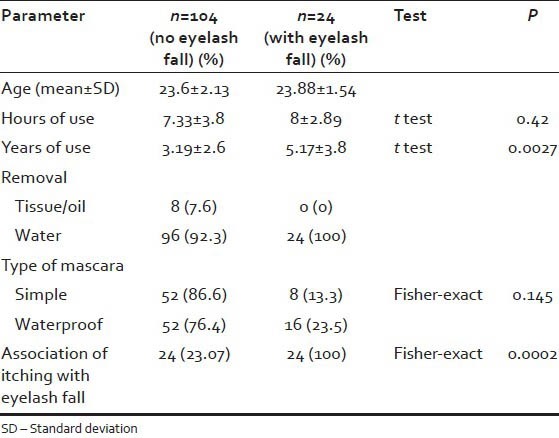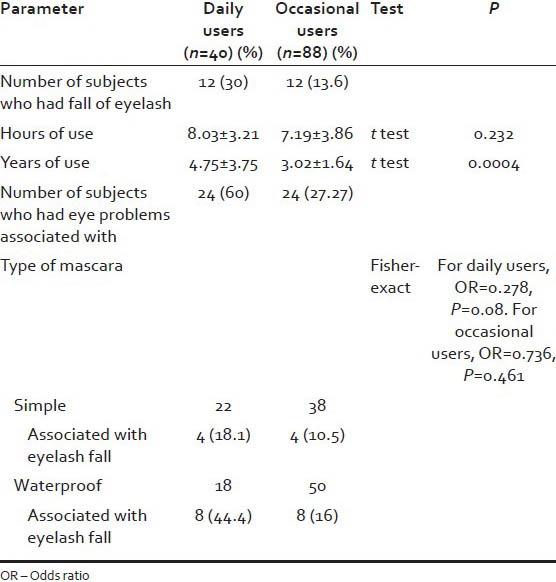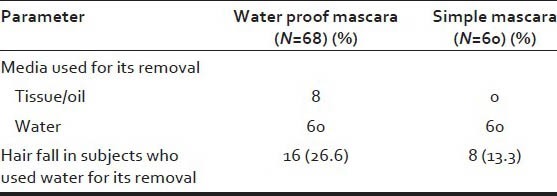Abstract
Context:
Eyelashes play an important role in one's personality and builds confidence. Now-a- days, mascaras are used very commonly as an eye cosmetic. Mascara induced loss of eyelashes has been evaluated in this study.
Aim:
The aim of this study is to determine the effect of mascara on eyelashes and to find an association between the usage of mascara and fall of eyelashes.
Settings and Design:
Cross-sectional questionnaire based study done on medical students.
Subjects and Methods:
Medical students were interviewed with a semi-structured questionnaire on mascara usage.
Statistical Analysis:
MedCalc 9.3.6.0 version.
Results:
A total of 128 medical students who used mascara were included in this study. Mean (standard deviation) age of the students was 23.7 ± 2.0 years. Nearly 31% of the subjects faced the eye problems. Eyelash fall was observed in 19%. Higher mean years of use of mascara (5.17 ± 3.8 vs. 3.19 ± 2.6, P = 0.027, t-test) influenced the fall of eyelashes in the subjects. Itching of the eye prior to fall of eyelashes was observed in all subjects (P = 0.0002, Fisher exact test). A higher percentage of eyelash falls was observed in subjects who used water for removal of waterproof mascara (27%).
Conclusion:
There is a significant positive association between long-term use of eye cosmetics like mascara and fall of eyelashes. Furthermore, use of water for removal of waterproof mascara was associated with a higher incidence of eyelash fall.
Keywords: Eyelashes, fall, mascara, milphosis
INTRODUCTION
The eyes are the symbol of beauty. Possession of long thick and dark eyelashes associated with amplified levels of attractiveness, confidence and well-being has been the desire of every woman.[1] Mascara, an eye cosmetic that temporarily darkens, lengthens and thickens eyelashes is often associated with chronic blepharitis and loss of eyelashes as a sequelae.[2] The term madarosis is used to describe general loss of both eyelashes (ciliary) and eyebrows (supraciliary). Loss of eyelash alone is also known as milphosis.[3,4] Medline search did not show persuasive studies concerning the effects of mascara and its effects. Previous reports though claim the effects resulting from mascara usage, the contributing key factors for the side-effects were of multi-factorial origin.[2,5] Our study aimed to find effects of use of mascara on eyelashes and the role of contributing factors in a uniform age group and individuals.
SUBJECTS AND METHODS
A total of 130 consecutive medical students who were interviewed and analysed by a single ophthalmologist over a 12 month period (December, 2011-February, 2013) were considered for the study. Subjects with previous history of eye trauma, previous recurrent infections and co-existing illness like diabetes mellitus type 1 or type 2 or any other systemic/connective tissue disorders, psychiatric illness or on medications which may precipitate hair loss were excluded. Written informed consent was taken from all the participants before the administration of the questionnaire and confidentiality was maintained. The study was approved by the institutional ethical committee. An interview-based questionnaire developed by the researcher was administered to each of the participant. The query included were: (a) Hours of usage of mascara, (b) years of usage of mascara, (c) type of mascara used, (d) washing pattern for its removal, (e) eye problems faced (redness, itching or any other), (f) eyelash problems faced, (g) knowledge about medication for growth of eyelashes.
Data is presented as mean with a standard deviation and 95% confidence intervals. Comparison of groups with or without hair fall for Statistical analysis was performed using MedCalc software (version 9.3.6.0, Belgium). Student's t-test, Fisher-exact test or Odd's ratios were used as appropriate.
RESULTS
The demographic data are shown in Table 1. Out of 130 subjects studied, 2 were excluded for the reasons mentioned earlier (wide supra). The overall incidence of eyelash fall observed was 19% and incidence of associated eye problems were 31%.
Table 1.
Demographic data

The objectives studied in relation to the hair fall included: (a) The groups of daily or occasional user subjects, (b) type of mascara used and (c) the material used for its removal. The factors in relation to the eyelash fall are explained through Table 2. Though the mean duration (hours/day) of use of mascara did not influence the study, higher years of use (P < 0.05, P = 0.027, t-test) influenced the fall of eyelashes in the subjects. Itching of eye prior to fall of eyelashes was observed in all the subjects (P = 0.0002, Fisher exact test).
Table 2.
Comparison of individuals with and without fall of eyelashes

The different variables associated with hair fall with respect to duration of usage of mascara were studied [Table 3]. There was equal distribution of subjects for different type of mascara (simple or waterproof) among daily and occasional users. A higher incidence of fall of eyelash was observed in daily users than occasional users (30% vs. 13.6%) though the mean hours of its application on each day were equal in subjects (P > 0.5). Furthermore, a higher incidence of eye problems (60% vs. 27%) was observed in daily users than occasional users. Within the groups of daily or occasional users, a higher incidence of hair fall was observed in the former group irrespective of the type of mascara used [Table 3]. However, between the groups (daily vs. occasional), the type of mascara did not affect the eyelash fall incidence [Fisher exact test, P > 0.05, [Table 3]. Finally, the factors for eyelash fall in relation to its removal when studied, a higher incidence of fall was associated with the use of water in subjects who used water proof mascara [27% vs. 13%, [Table 4].
Table 3.
Association of variables with respect to type of mascara usage

Table 4.
The association between the hair fall and its removal

Artificial eyelashes were not used by any students and none had awareness regarding usage of topical medication for the lengthening of lashes.
DISCUSSION
Highlighting and emphasizing the eye has been possible with a wide variety of eye cosmetics available. They include eye shadow, under eye concealers, eyeliners, mascaras, artificial eyelashes, eyebrow pencils.[1] Mascara has been the oldest and most commonly used option. This usually contains a mixture of waxes and pigments in addition to resins or petroleum distillates.[6] Effects of mascara are temporary. Risk of microbial contamination is always a problem.[7] In a study conducted by Abdelaziz et al.[8] Staphylococcus epidermidis was the common organism. Pseudomonas aeruginosa, Citrobacter freundii, Klebsiella pneumonia were the micro-organisms isolated from mascara.[8] However, mascaras were more contaminated than eyeshadows and these microbes can cause chronic blepharitis and loss of eyelashes as a sequelae.[8]
We observed a definitive higher incidence of milphosis, as a complication following usage of mascara in our study subjects. The various causes for the fall of eyelashes in our subjects were studied. Since we did not observe significant association between daily and occasional users of mascara for eyelash fall, we could suspect a different etiological factor/s for its occurrence. The higher incidence in the loss of eyelashes was associated with the longer duration of usage strengthens the “long-term duration use” as etiological role. However, “short term duration use” in each day did not affect the outcome. This is because our study subjects had uniform duration of use in each day and we could not conclude whether this single factor had any influence on eyelash fall.
The daily use of mascara was associated with a higher incidence of eye-related problems. Though none of the subjects developed serious insults on eye, the associated minor ones could be attributed to a constant chemical or biological irritant stimulus. The eyelash fall was always followed by a previous eye symptom; the role of a possible chemical inflammatory reaction could not however be excluded.
The majority of subjects used water for removal of mascara in our study. Only meager individuals used either a tissue or oil for its removal. Inadequate knowledge among the subjects, ease of availability of water may be impulsive issues for such an occurrence. Removal of the waterproof mascaras is a constant well-known problem faced by its users. Vigorous rubbing using fingers during removal with water can cause loss of eyelashes and thus may be the primary reason in our study subjects.
Prominent eyelashes as desired by women enhances beauty. Bimatoprost (0.03%) an antiglaucoma medication has been approved for the treatment of hypotrichosis of eyelashes by U.S. Food and Drug Administration.[6,9] Bimatoprost (0.03%) an ophthalmic solution used in the management of glaucoma applied once daily to skin of upper eyelid margins using single use, per eye application increases length, thickens, darkness and growth of eyelashes.[6,10,11] Medical students who took part in our study weren’t aware of usage of any eyedrops for growth of eyelashes. Psychiatric disease trichotillomania where one keeps pulling the hairs results in noticeable hair loss. These patients may benefit from bimatoprost (0.03%) by increased lash growth, patients self-image can be improved.[12]
Though multi-factorial etiological factors for eyelash loss exist, the primary factor, which may play an important role, is the duration of the mascara use irrespective of its type and the nature of material used for its removal. Since the study was done in individuals who were using the mascara for long years, the errors are always possible owing to memory disclosure regarding type, nature and duration of mascara variants.
CONCLUSION
Long, thick eyelashes desired by women need adequate care for its preservation. The use of eye cosmetics for long duration is associated with fall of lashes, the removal of the same should be considered as the causative factor. The use of water for removal may be associated with a higher incidence of eyelash loss in an individual who has used a water proof eye cosmetic. A further study may be required in this direction for assessing the other co-existing etiological factors which may play a role in eyelash fall.
ACKNOWLEDGEMENT
The authors would like to acknowledge the assistance of Dr. Nandini Bothra, Resident, Department of Ophthalmology, A. J. Institute of Medical Sciences, Mangalore, India in collecting the data for this study.
Footnotes
Source of Support: Nil
Conflict of Interest: None declared.
REFERENCES
- 1.Draelos ZK. Eye cosmetics. Dermatol Clin. 1991;9:1–7. [PubMed] [Google Scholar]
- 2.Wilson LA, Julian AJ, Ahearn DG. The survival and growth of microorganisms in mascara during use. Am J Ophthalmol. 1975;79:596–601. doi: 10.1016/0002-9394(75)90798-9. [DOI] [PubMed] [Google Scholar]
- 3.Sachdeva S, Prasher P. Madarosis: A dermatological marker. Indian J Dermatol Venereol Leprol. 2008;74:74–6. doi: 10.4103/0378-6323.38426. [DOI] [PubMed] [Google Scholar]
- 4.Khong JJ, Casson RJ, Huilgol SC, Selva D. Madarosis. Surv Ophthalmol. 2006;51:550–60. doi: 10.1016/j.survophthal.2006.08.004. [DOI] [PubMed] [Google Scholar]
- 5.Ciolino JB, Mills DM, Meyer DR. Ocular manifestations of long-term mascara use. Ophthal Plast Reconstr Surg. 2009;25:339–41. doi: 10.1097/IOP.0b013e3181ab443e. [DOI] [PubMed] [Google Scholar]
- 6.Fagien S. Management of hypotrichosis of the eyelashes: Focus on bimatoprost. Clin Cosmet Investig Dermatol. 2010;3:39–48. doi: 10.2147/ccid.s5488. [DOI] [PMC free article] [PubMed] [Google Scholar]
- 7.Pack LD, Wickham MG, Enloe RA, Hill DN. Microbial contamination associated with mascara use. Optometry. 2008;79:587–93. doi: 10.1016/j.optm.2008.02.011. [DOI] [PubMed] [Google Scholar]
- 8.Abdelaziz AA, Ashour MS, Hefni H, el-Tayeb OM. Microbial contamination of cosmetics and personal care items in Egypt – Eye shadows, mascaras and face creams. J Clin Pharm Ther. 1989;14:21–8. doi: 10.1111/j.1365-2710.1989.tb00217.x. [DOI] [PubMed] [Google Scholar]
- 9.Cohen JL. Enhancing the growth of natural eyelashes: The mechanism of bimatoprost-induced eyelash growth. Dermatol Surg. 2010;36:1361–71. doi: 10.1111/j.1524-4725.2010.01522.x. [DOI] [PubMed] [Google Scholar]
- 10.Law SK. Bimatoprost in the treatment of eyelash hypotrichosis. Clin Ophthalmol. 2010;4:349–58. doi: 10.2147/opth.s6480. [DOI] [PMC free article] [PubMed] [Google Scholar]
- 11.Smith S, Fagien S, Whitcup SM, Ledon F, Somogyi C, Weng E, et al. Eyelash growth in subjects treated with bimatoprost: A multicenter, randomized, double-masked, vehicle-controlled, parallel-group study. J Am Acad Dermatol. 2012;66:801–6. doi: 10.1016/j.jaad.2011.06.005. [DOI] [PubMed] [Google Scholar]
- 12.Peabody T, Reitz S, Smith J, Teti B. Clinical management of trichotillomania with bimatoprost. Optom Vis Sci. 2013;90:e167–71. doi: 10.1097/OPX.0b013e318294c158. [DOI] [PubMed] [Google Scholar]


